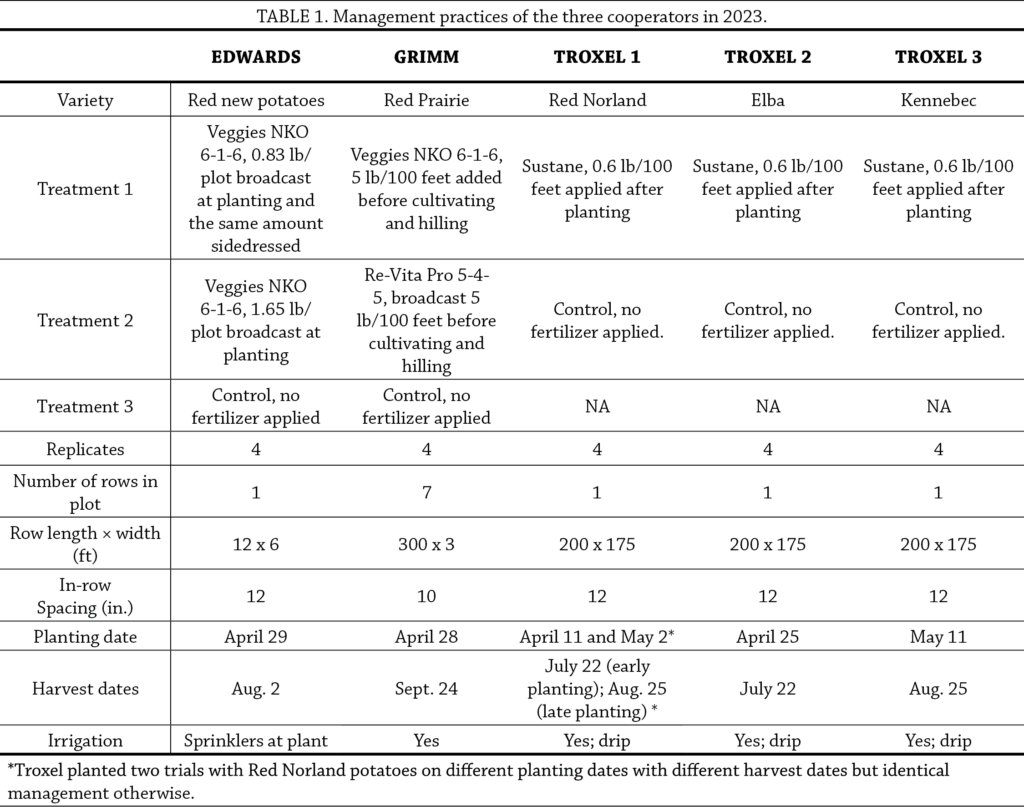This research report was funded by Stranahan Foundation and Ceres Trust.
In a Nutshell:
- Potatoes have notoriously high nutrient demands and organic fertilizers can help maximize yield and long-term soil fertility in organic potato fields.
- Kate Edwards, Jason Grimm and Terry Troxel all wanted to identify how different organic fertilizers affect potato yields on their operations.
Key Findings
- Grim and Troxel both found that fertilized potatoes outyielded unfertilized potatoes. Edwards found no differences in yield between fertilized and unfertilized potatoes.
- Troxel found that while fertilizer increased the yield and total number of potatoes, it did not affect the proportional sizes of the potatoes. In other words, fertilizing produced more potatoes but not bigger potatoes.
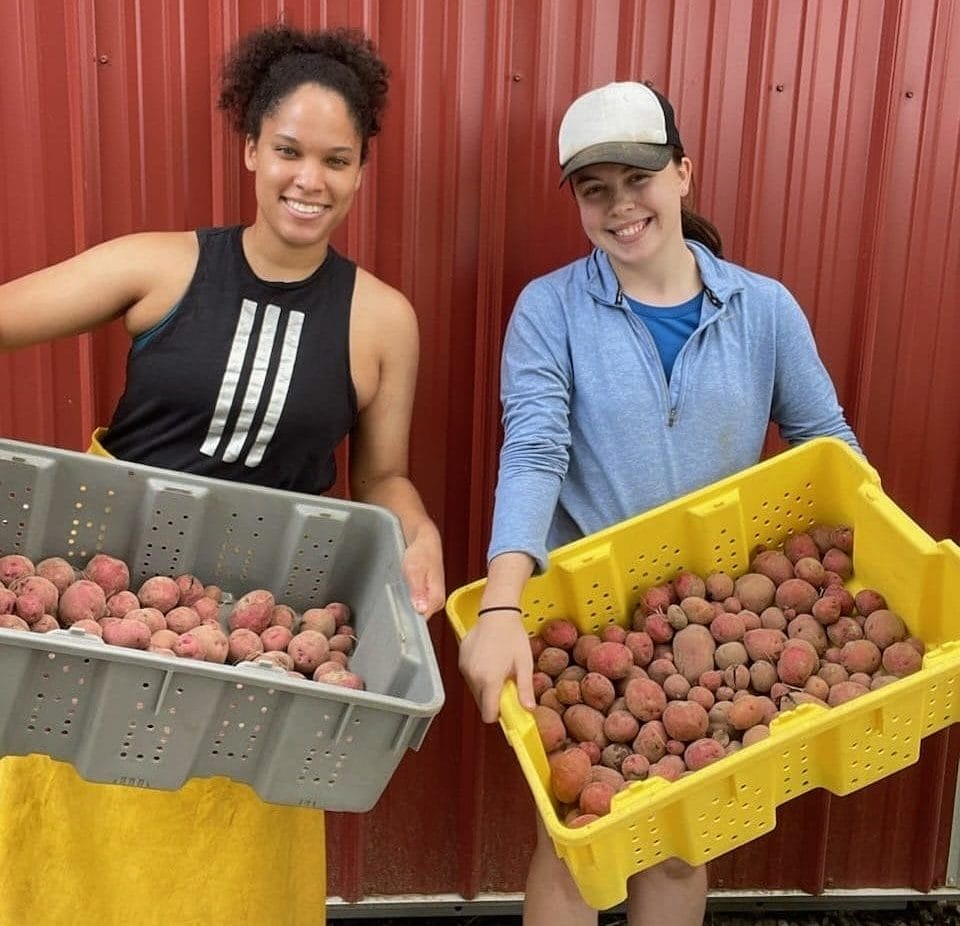
Georgia Conrad (left) and Hailey Frank (right) with potatoes harvested from Kate Edward’s trial. Photo taken August 1, 2023.
Background
Potatoes have higher nutrient demands than many other horticultural crops and therefore require extra care in terms of nutrient management to maximize yield, quality and long-term soil health [1]. There are a wide variety of organic fertilizer options available to organic farmers, but it is often difficult to identify what fertilizer type and rate is best to use to maximize yields and minimize costs. Kate Edwards, Jason Grimm and Terry Troxel conducted a trial to assess how commercially available organic fertilizers affect potato yields on their operations. Reflecting a goal shared by other participants, Grimm shared that his reasoning for undertaking the trial was that “I would like it to improve our potato yield and help dial in a nutrient management program for future seasons.” Edwards added that the large amount of land she currently needs to grow potatoes was another reason to hone her potato fertilization practices; “We have extra land that we rent to grow potatoes, but we may not always have that land. I would like to increase yield per row foot so we can mitigate any future land access challenges.”
Methods
Design
Each farmer had different soils, fertilizer options and preferences, so they each picked one to two different fertilizers or application rates that made the most sense for them and established a control with no commercial fertilizer applied (Table 1). They established their fertilizer treatments in randomized plots with no less than four replications (Figure A1). When possible, cooperators included a non-treated buffer row between plots and replications.
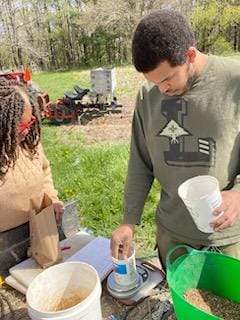
Monique Washington and Jasper Washington (right) weighing fertilizer to apply to treatments in Edward’s trial. Photo taken April 29, 2023.

Jasper Washington, Monique Washington and Kate Edwards with the potato planter and seed potatoes. Photo taken April 29, 2023.
Measurements
Cooperators each measured the weight of all marketable potatoes per plot fresh from the field with no curing. Troxel also chose a subset of 10 potato plants from replicates in two of her trials, sorted the potatoes from those plants by size, grouping by 0.1 lb increments, and recorded the weight of each size class (Figure 3). Troxel then calculated potato size ratio as the proportion of potato weight in each size class.
Data analysis
To evaluate effects of the treatments on potato yield and potato size ratios, we used an analysis of variance test or a t-test to determine if there were differences between treatments, followed by a Tukey’s test to determine the least significant differences (LSDs) between treatments at the 95% confidence level. The difference between each treatment’s average potato yield is compared with the LSD. A difference greater than or equal to the LSD indicates the presence of a statistically significant treatment effect, meaning one treatment outperformed the other and the farmer can expect the same results to occur 95 out of 100 times under the same conditions. A difference smaller than the LSD indicates the difference is not statistically significant and the treatment had no effect. We could make these statistical calculations because the cooperators’ experimental design involved randomization and replication of the treatments (Figure A1).
Results and Discussion
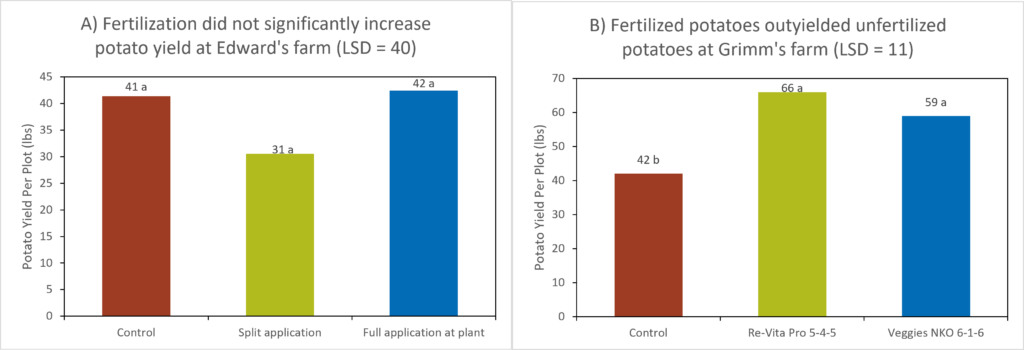
Figure 1. Potato yields at A) Edwards’ and B) Grimm’s. Different letters above bars indicate significantly different yields within each farm based on LSD tests. Click to enlarge.
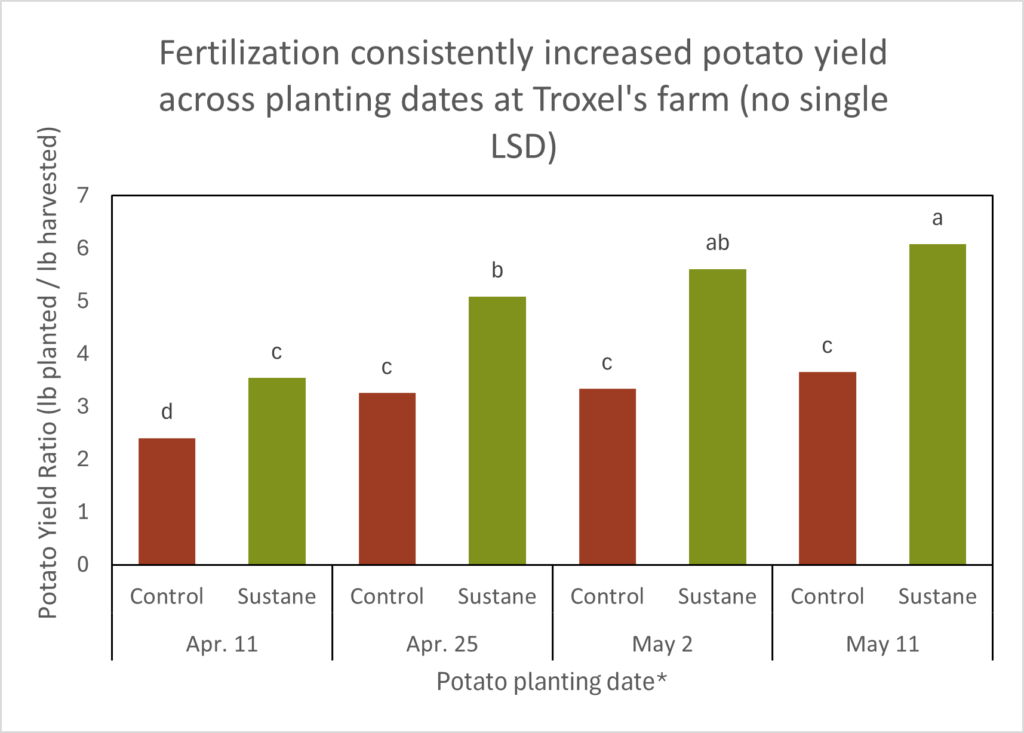
Figure 2. Potato yield ratios at Troxel’s. Since Troxel planted different amounts of potatoes per plot across her trials, we calculated yield ratio as the ratio of weight of potatoes planted to weight of potatoes harvested for comparability across trials. Letters indicate significantly different yields based on LSD test, though not single LSD value was available due to uneven number of replicates per treatment. * Troxel planted different potato varieties on her four different planting dates; April 11 and May 2 were both Red Norland potatoes, April 25 was Elba and May 11 was Kennebec (Table 1). Each planting date had a full four replicates of each treatment. Click to enlarge.
Yield
Overall, two of three cooperators found that fertilizer significantly increased potato yields, while drought likely negatively affected yields throughout all the trials. Edwards found that neither her split application fertilizer treatment nor her at-plant application fertilizer treatment resulted in increased yield compared to her control, no fertilizer applied treatment (Figure 1A). Edwards was surprised by this finding, saying “I want to do a follow up study to make sure the results aren’t from an external factor like the drought.” Grimm and Troxel, in contrast, both found that fertilization increased their potato yields significantly. Grimm’s fertilized potatoes averaged 63 lb/plot, while his unfertilized potato yield averaged 42 lb/plot (Figure 1B). There was no difference in yield between the two fertilizer treatments that he tried, Revita Pro 5-4-5 and Veggies NKO 6-1-6, despite the nutrient differences contained in the two different mixes. Troxel found that on all four of the replicated trials she ran, fertilizer increased potato yield ratios to an average of 60% greater than unfertilized potato yields (Figure 2).
Size Ratios
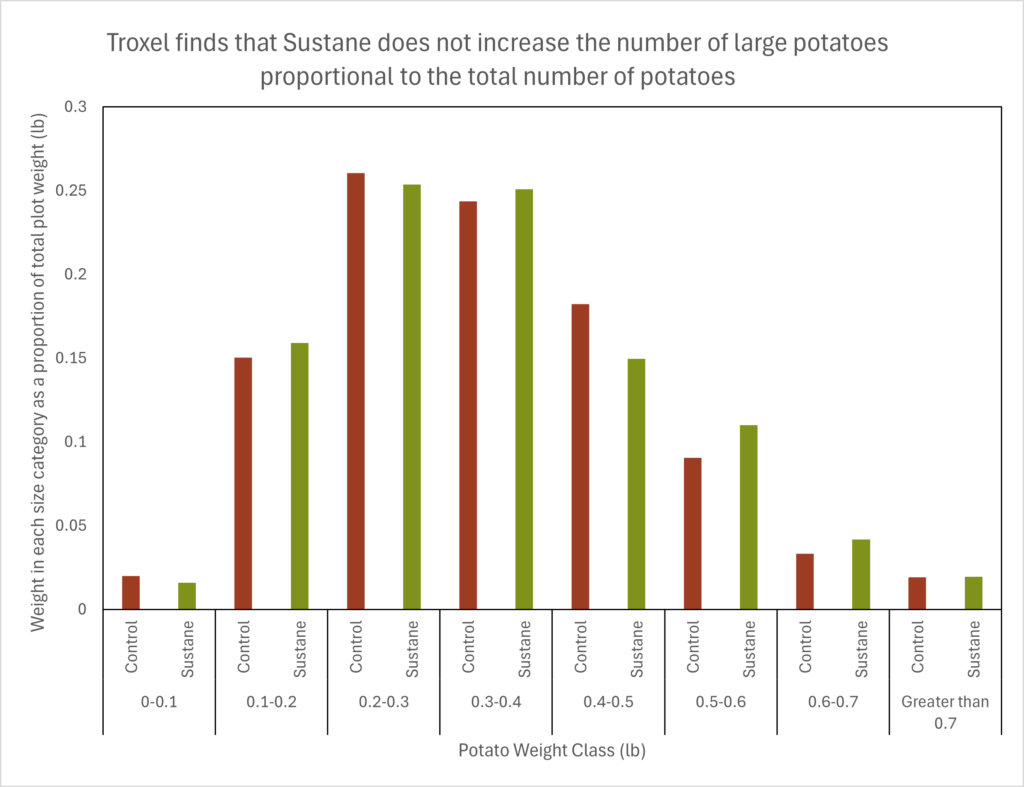
Figure 3. Potato weight in each of eight size classes as a proportion of the total weight of the potato harvest at Terry Troxel’s. There were no significant differences in the proportion of smaller or larger potatoes to the weight of the whole potato harvest by fertilizer treatment. In other words, Sustane did not affect the size of potatoes produced. No single LSD is available because of unequal sample size. Click to enlarge.
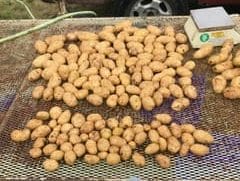
Potatoes from one of Terry Troxel’s control treatments sorted by size on a washing table. Photo taken Aug. 25, 2023.
Troxel also investigated whether fertilizer affected the size of potatoes produced because size is an important factor in her marketing. She found that her fertilizer treatment did not affect the ratio of large to small potatoes (Figure 3). However, she was pleased that the plants produced more potatoes overall and proportionally more large potatoes.
Conclusions and Next Steps
Troxel, who found that Sustane increased her potato yields, reflected that “it is so easy to add Sustane fertilizer and it is economical. Why wouldn’t I use it?” Edwards proposed additional follow up studies that go deeper into the mechanics of what nutrients can optimize potato growth, saying that next year “I’d like to either do a larger rate difference or a fertilizer type that includes other nutrients like sulfur or calcium which I think can also affect yields.” PFI’s horticulture cooperators will continue experimenting with organic fertilizer types and rates for various horticultural crops including potatoes to maximize yield and minimize costs.
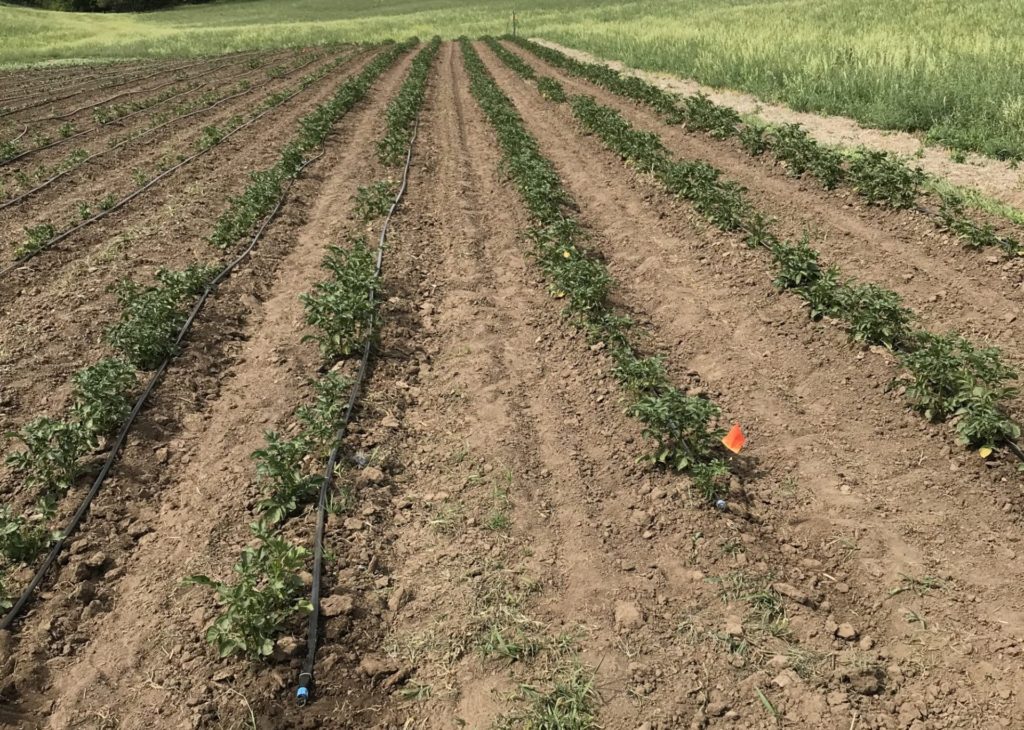
One of Terry Troxel’s potato fields with drip irrigation running. There are no visible differences between fertilization treatments. Photo taken May 31, 2023.
Appendix – Trial Design and Weather Conditions
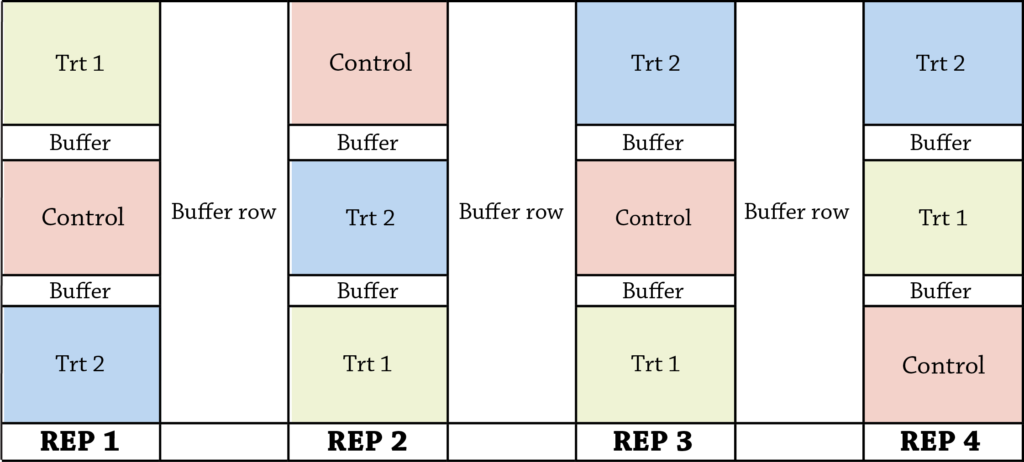
Figure A1. Example of experimental design used by Edwards, Faux, Grimm, and Troxel, which included randomized replicated plantings of each organic fertilizer treatment. This design allowed for statistical analysis of the results.
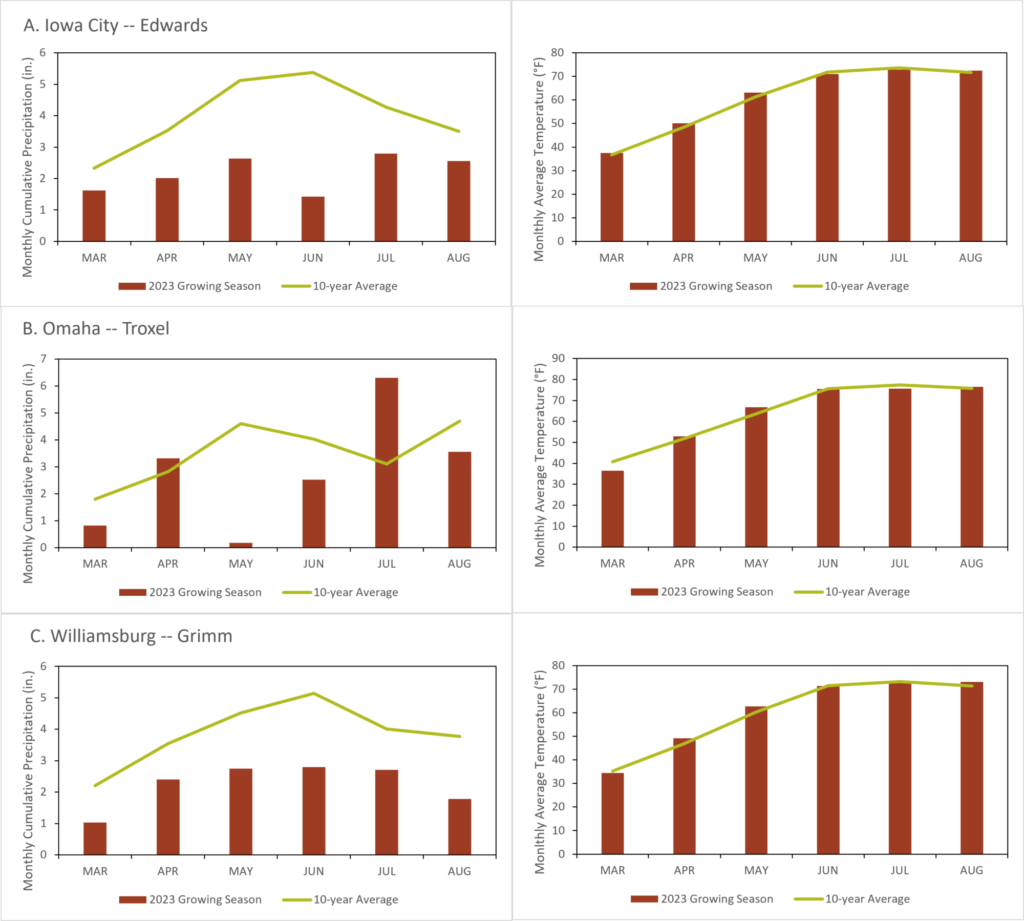
Figure A2 Weather data from the 2023 growing season and 10-year climate averages at: A) Solon (Edwards) B) Williamsburg (Grimm) C) Crescent (Troxel). Left graphs show monthly precipitation accumulation in 2023 vs. 10-year normal and right graphs show monthly average temperature in 2023 vs. 10-year normal. [2] Click to enlarge.
References
[1] A. Moore, N. Olsen, M. Satterwhite, and M. J. Frazier, “Organic potato production in Idaho: Nutrient management and variety selection”.
[2] Climodat Reports, “Iowa Environmental Mesonet.” Iowa State University. [Online]. Available: http://mesonet.agron.iastate.edu/climodat/


